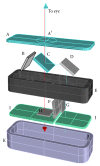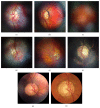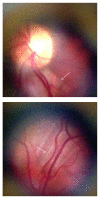A Novel Device to Exploit the Smartphone Camera for Fundus Photography
- PMID: 26137320
- PMCID: PMC4468345
- DOI: 10.1155/2015/823139
A Novel Device to Exploit the Smartphone Camera for Fundus Photography
Abstract
Purpose. To construct an inexpensive, convenient, and portable attachment for smartphones for the acquisition of still and live retinal images. Methods. A small optical device based on the principle of direct ophthalmoscopy was designed to be magnetically attached to a smartphone. Representative images of normal and pathological fundi were taken with the device. Results. A field-of-view up to ~20° was captured at a clinical resolution for each fundus image. The cross-polarization technique adopted in the optical design dramatically diminished corneal Purkinje reflections, making it possible to screen patients even through undilated pupils. Light emission proved to be well within safety limits. Conclusions. This optical attachment is a promising, inexpensive, and valuable alternative to the direct ophthalmoscope, potentially eliminating problems of poor exam skills and inexperienced observer bias. Its portability, together with the wireless connectivity of smartphones, presents a promising platform for screening and telemedicine in nonhospital settings. Translational Relevance. Smartphones have the potential to acquire retinal imaging for a portable ophthalmoscopy.
Figures





References
LinkOut - more resources
Full Text Sources
Other Literature Sources

